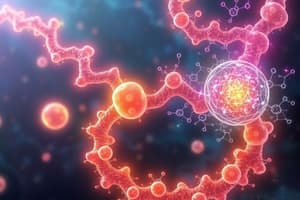Podcast
Questions and Answers
What percentage of liberated amino acids is typically recaptured for biosynthesis of new tissue protein in adults?
What percentage of liberated amino acids is typically recaptured for biosynthesis of new tissue protein in adults?
- 60-70%
- 75-80% (correct)
- 80-90%
- 50-60%
What is the effect of glucocorticoids on muscle tissue protein?
What is the effect of glucocorticoids on muscle tissue protein?
- Increase protein synthesis
- Increase protein degradation (correct)
- No effect on protein levels
- Cause protein denaturation
Which of the following represents a consequence of lysosomal activation?
Which of the following represents a consequence of lysosomal activation?
- Decreased intracellular proteolytic rate
- No change in protein turnover
- Increased intracellular proteolytic rate (correct)
- Increased extracellular protein synthesis
In normal physiological conditions, how does the rate of protein synthesis compare to the rate of protein degradation?
In normal physiological conditions, how does the rate of protein synthesis compare to the rate of protein degradation?
Which hormone is primarily associated with increasing protein turnover?
Which hormone is primarily associated with increasing protein turnover?
What is the primary fate of the remaining 20-25% of liberated amino acids after protein degradation?
What is the primary fate of the remaining 20-25% of liberated amino acids after protein degradation?
During the degradation process, what happens to the carbon skeletons of amino acids?
During the degradation process, what happens to the carbon skeletons of amino acids?
What is the primary role of protein degradation in adults?
What is the primary role of protein degradation in adults?
What influences the half-life of a protein like trypsinogen?
What influences the half-life of a protein like trypsinogen?
What is the half-life of a protein with serine as its N-terminal amino acid?
What is the half-life of a protein with serine as its N-terminal amino acid?
What is one of the main consequences of diets low in protein?
What is one of the main consequences of diets low in protein?
What does trypsin do besides activating itself?
What does trypsin do besides activating itself?
What is the recommended dietary allowance for protein for a 70 kg individual?
What is the recommended dietary allowance for protein for a 70 kg individual?
What condition could lead to pancreatic secretion deficiency?
What condition could lead to pancreatic secretion deficiency?
Which of the following is classified as a pancreatic zymogen?
Which of the following is classified as a pancreatic zymogen?
What can result from a deficiency in pancreatic secretion?
What can result from a deficiency in pancreatic secretion?
What is the primary function of active transport systems in relation to amino acids?
What is the primary function of active transport systems in relation to amino acids?
Which amino acids have the highest gradient size in active transport systems?
Which amino acids have the highest gradient size in active transport systems?
What is the role of Na+ in the luminal transport process regarding amino acids?
What is the role of Na+ in the luminal transport process regarding amino acids?
Which of the following accurately describes the COAL system?
Which of the following accurately describes the COAL system?
Which product results from the peptic hydrolysis of proteins?
Which product results from the peptic hydrolysis of proteins?
How does pepsin function in the stomach?
How does pepsin function in the stomach?
What primarily drives the active transport of amino acids?
What primarily drives the active transport of amino acids?
Which statement about contraluminal transport is accurate?
Which statement about contraluminal transport is accurate?
What are the primary elements that make up amino acids?
What are the primary elements that make up amino acids?
What is the end product of the removal of alpha-amino groups during the first phase of amino acid catabolism?
What is the end product of the removal of alpha-amino groups during the first phase of amino acid catabolism?
How are alpha-ketoacids relevant to amino acids?
How are alpha-ketoacids relevant to amino acids?
What byproduct of amino acid catabolism is primarily used for urea synthesis?
What byproduct of amino acid catabolism is primarily used for urea synthesis?
What process is involved in the hydrolysis of polypeptides to free amino acids?
What process is involved in the hydrolysis of polypeptides to free amino acids?
Which of the following are common dietary sources of amino acids?
Which of the following are common dietary sources of amino acids?
What is the approximate daily intake of dietary protein that provides amino acids?
What is the approximate daily intake of dietary protein that provides amino acids?
What occurs to excess amino acids that cannot be stored in the body?
What occurs to excess amino acids that cannot be stored in the body?
Which statement accurately describes the process of transamination?
Which statement accurately describes the process of transamination?
In which of the following conditions would you expect increased plasma levels characterized by ALT < AST?
In which of the following conditions would you expect increased plasma levels characterized by ALT < AST?
Which organ primarily facilitates oxidative deamination, resulting in the release of free ammonia?
Which organ primarily facilitates oxidative deamination, resulting in the release of free ammonia?
What is the initial step in amino acid catabolism?
What is the initial step in amino acid catabolism?
What characterizes nonhepatic disease in terms of plasma enzyme levels?
What characterizes nonhepatic disease in terms of plasma enzyme levels?
Flashcards are hidden until you start studying
Study Notes
Overview of Amino Acids and Nitrogen Disposal
- Amino acids are composed of carbon (C), hydrogen (H), oxygen (O), and nitrogen (N) atoms.
- Excess amino acids cannot be stored; they are rapidly degraded.
- Amino acids are derived from dietary intake, de novo synthesis, and normal protein degradation.
Catabolism of Amino Acids
-
First Phase:
- Involves the removal of alpha-amino groups via transamination and oxidative deamination.
- Products are ammonia and corresponding alpha-ketoacids.
- Ammonia primarily contributes to urea synthesis, excreted in urine.
- Alpha-ketoacids serve as carbon skeletons for amino acids.
-
Second Phase:
- Carbon skeletons of alpha-ketoacids are intermediates in energy metabolism.
- Daily dietary input: 70-100 grams of dietary protein and 35-200 grams of endogenous protein.
- Proteins are hydrolyzed to free amino acids for absorption, aided by proteolytic enzymes.
Protein Denaturation and Turnover
- Adults degrade 1-2% of total body protein daily, mostly from muscle.
- 75-80% of liberated amino acids are recaptured for new tissue protein synthesis; remaining 20-25% is converted to urea.
- Loss of native protein configuration leads to increased proteolytic breakdown.
Factors Influencing Protein Turnover
- Glucocorticoids: Increase degradation of muscle tissue protein.
- Thyroid Hormone Excess: Enhances protein turnover rate.
- Insulin: Affects protein half-life based on the N-terminal residue of proteins.
Role of Dietary Protein
- Provides energy secondarily after carbohydrates and fats.
- Recommended Dietary Allowance (RDA) for protein is 56 grams per day for a 70 kg individual.
- Low protein diets can lead to incomplete protein digestion and absorption issues, leading to steatorrhea.
Digestion of Proteins
- Pepsin, secreted in inactive form (pepsinogen) by stomach serous cells, is an acid-stable endopeptidase that denatures proteins.
- Main products from peptic hydrolysis include large polypeptides and some free amino acids.
Amino Group Handling and Deamination
- Nonhepatic diseases can cause increased plasma levels of transaminases, especially after myocardial infarction or muscle disorders.
- Transamination transfers amino groups from amino acids to α-keto acids.
- Oxidative deamination liberates amino groups as free ammonia, primarily in the liver and kidney.
Transport Mechanisms
- Active transport systems drive amino acids from lower to higher concentration areas, utilizing ATP.
- Variability in amino acid transport gradients; highest for glutamate and glutamine.
- COAL System mediates uptake of cystine and dibasic amino acids like ornithine, arginine, and lysine.
- Na+-dependent and Na+-independent transport mechanisms operate for luminal and contraluminal transport, respectively.
Studying That Suits You
Use AI to generate personalized quizzes and flashcards to suit your learning preferences.



